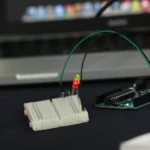
Introduction
In the realm of excessive use of portable electronics, electric vehicles, and renewable energy storage, battery safety circuits are significant in ensuring the reliability and safety of battery-powered devices. These circuits are designed to protect batteries from conditions that could lead to failure, damage, or dangerous situations, such as overheating, overcharging, and short-circuiting. This article introduces why battery safety circuits are indispensable for your devices, outlining their importance, functions, and the advancements in technology that continue to improve battery safety.
Understanding Battery Safety Circuit
Battery safety circuits, also called battery protection circuits, are electronic circuits integrated into battery packs or systems to monitor and control the charging and discharging processes. These critical components ensure our reliance on batteries does not come at the cost of safety. A battery protection circuit primarily functions to restrict the battery from operating from outside its safe operating area (SOA), thus ensuring the longevity and safety of the battery.
What is a Lithium-ion Battery Safety?
Lithium-ion batteries are popular because of their long-lasting performance, high energy density, and the capability to store a maximum amount of energy in a relatively compact size. However, the widespread use of lithium-ion batteries also poses safety risks due to their chemical composition and potential for overheating, short-circuiting, or even catching fire. This is where battery safety circuit ensure the safe and reliable operation of our devices.
The Rise of Portable Devices: Exploring the Need For Battery Safety Circuit
The proliferation of consumer electronics, including smartphones, laptops, tablets, wearables, and other portable electronic devices has significantly contributed to the demand for efficient and reliable battery technologies. Lithium-ion batteries, in particular, are the preferred choice due to their lightweight nature, high efficiency, and rechargeability.
Beyond consumer electronics, battery safety circuits are indispensable in industrial and automotive applications where large battery packs are used. In electric vehicles, for example, these circuits not only protect the batteries from overcharging and over-discharging but also optimise battery performance, extend battery life, and ensure the passengers’ and bystanders’ safety.
Key Functions of Battery Safety Circuits
Battery safety circuit typically serve several vital functions to protect both the battery and the device it powers. Some of the typical functions of battery protection circuits include:
- Overcharge Protection: These circuits prevent the battery voltage from exceeding its maximum threshold during charging, which can lead to overheating, leakage, or even explosion.
- Overdischarge Protection: Overdischarge can damage the battery and shorten its lifespan. Safety circuits prevent the battery voltage from dropping below its minimum threshold, extending their service life safely.
- Short Circuit Protection: Bespoke innovative circuits detect and interrupt short circuit conditions promptly to prevent excessive current flow, which can cause overheating and fire.
- Temperature Monitoring: Battery safety circuits ensure the battery operates within its safe temperature range, protecting against extreme temperature conditions that can cause battery degradation or failure.
Battery Safety Circuits are of Significant Importance: Unveiling Their Benefits
The significance of it cannot be overstated. They are essential for:
- – Preventing Accidents: By controlling the conditions under which batteries operate, safety circuits significantly reduce the risk of fires, explosions, and other hazardous incidents.
- – Preventing Battery Failures: The primary role of battery safety circuits is to prevent failures by immediately cutting off the power if any parameter exceeds its safety limits. This protection is crucial for lithium-ion batteries, which are particularly sensitive to overcharging and overheating.
- – Enabling Advanced Applications: The reliability provided by safety circuits allows batteries to be used in a myriad of applications––from consumer electronics to electric vehicles and grid-scale energy storage systems.
Technological Advancements in Battery Safety
The continuous progression of battery technology has led to significant improvements in safety circuit designs. Some advancements include:
Smart Battery Management Systems (BMS)
Modern BMS integrate sophisticated algorithms and sensors to monitor battery health in real-time, offering dynamic protection based on the battery’s condition and the external environment.
Solid-State Batteries
The development of solid-state batteries, which replace liquid electrolytes with solid electrolytes, promises to enhance safety by reducing the risk of leakage and thermal runaway.
Wireless Battery Management Systems
Emerging technologies enable wireless communication within battery packs, improving safety by eliminating wiring faults and enabling more flexible and robust battery designs.
Bottom Lines
Battery safety circuits are indispensable components that ensure the safe, reliable, long-lasting, and efficient operation of battery-powered devices. Through continuous technological advancements, these circuits are becoming smarter, more integrated, and more robust to protect against a wide range of battery-related hazards. As we rely more on batteries to power our lives, the importance of it will continue to grow––highlighting the need for ongoing research and development in this critical field.





















